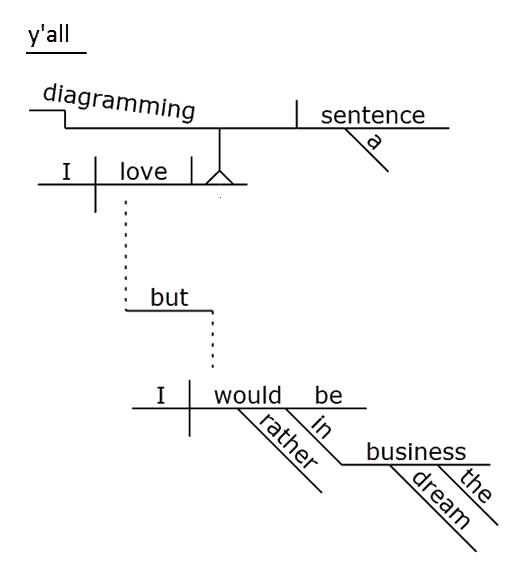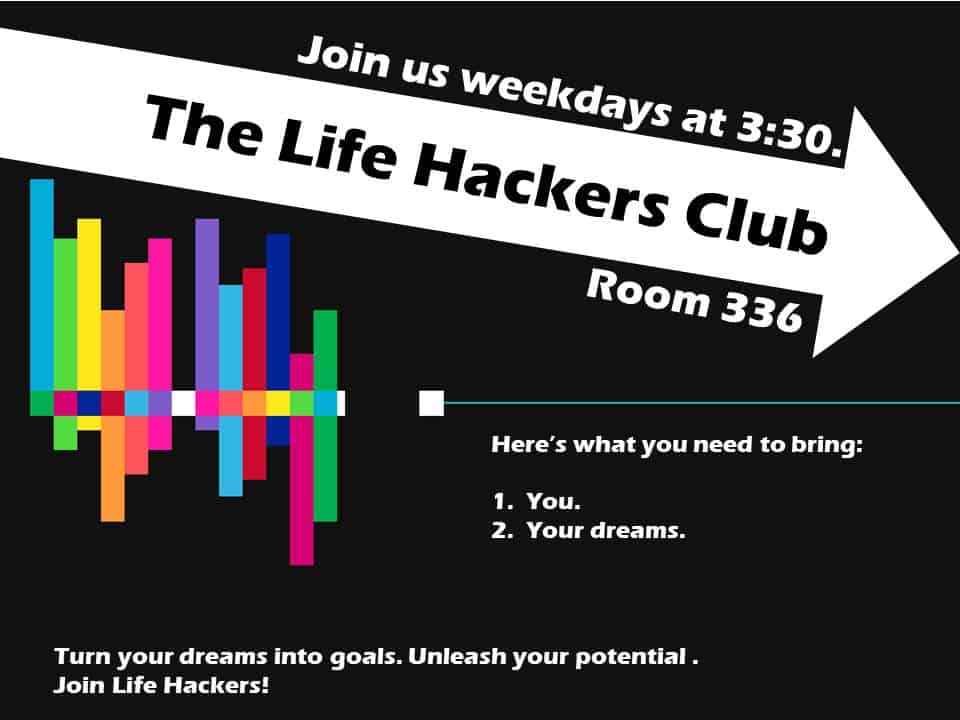Start a Life Hacker Club at Your School

Are you looking for a different type of club for your students after school? You should consider a life hacker club.
Sounds great, but what is it?
A life hacker club gives students the right tools, skills, attitudes, and beliefs to pursue their own dreams and discover their full potential and realize the opportunities that the 21st Century offers.
Life hackers take responsibility for their own pursuits. The club advisor serves as the essential mentor who guides them and inspires them along the way. All life hacker club advisors will be mentioned in graduation speeches as the single most important person in helping that speaker in life.*
*Results may vary.
Isn’t hacking a bad thing?
No, not at all. The term was hijacked for a time, but it’s quickly regaining its former status. Here’s the wiki definition:
Life hacking refers to any productivity trick, shortcut, skill, or novelty method to increase productivity and efficiency, in all walks of life; in other words, anything that solves an everyday problem in a clever or non-obvious way.
The life hacker club takes that core definition and applies it to the pursuit of goals. Before you dismiss life hacks, think about this. You know how we often struggle to connect our classroom lessons to the real world? Well, life hacks are nothing but real world. They aren’t just theory or academia. Whenever you see someone accelerate rapidly in their development, they’ve more than likely discovered a life hack.
What Life Hacking Is Not
A life hacker club isn’t about tech tools. It’s about people. A life hacker club can’t be successful without the extraordinary people who have dedicated themselves to preparing the next generation of citizens. We call those people “teachers.” Teachers use tools to connect students to 21st-century opportunities that let them fulfill their dreams.
A life hacker club isn’t about STEM. You can’t swing Schrödinger’s Cat without hitting two new STEM initiatives. We got that covered during a student’s 8 to 3 time. The life hacker club is after school. That is student time. Kid time. Prime time. It’s time that is important to them. The life hacker club isn’t about getting students to do what we want them to do. It’s about us facilitating their dreams. People can either build their own dreams or they can spend their whole lives building dreams for others. The life hacker club helps members realize that they can build their own dreams.
I love diagramming a sentence, y’all, but I would rather be in the dream business.
The Life Hacker Club Basics
Let’s get to it. Below are the tools and processes that I’ve found work best. They work best for me and my particular group of mentees. Again, it’s not the tool itself, but the desired outcomes that are important. You’ve probably seen this:
That left column looks awesome and is filled with a lot of my favorite action: DO.
That’s students DOing something. The left column, though, really pales in comparison to the right column. The left column can represent different aisles at Office Max. The right column is TedTalks. The left column is the behind-the-scenes at the life hacker club. The right column is the life hacker highlight reel.
What You Need
Club Members – Your students will be motivated to be in the club. They wouldn’t be there otherwise. They might not have a clue what it means to reach their dreams, but they have dreams that they want to explore. Some might have it figured out already. They only need some structure. Others might just know that their current station in life is not where they want to be. They are the flower that somehow blooms in a nest of thorns. You can picture clearly in your mind the student that I’m talking about.
Develop a flier that will attract members. Start small, and let the word spread. This will give you time to get familiar with the processes. Your first members will become mentors for new members.
Goal Declarations – Have members determine what their goals are. They literally need to list them and then explore what those goals mean. Emphasize that this is not a wish list that they will dream about. This is a goal list that they will work on. Help them determine which area of life their goals fit into. Common areas are creativity, finance, health, spirit, career, relationships, and lifestyle. Whichever area it is, they will explore that entire area during life hacker club.
Work Space – A life hacker club is unconventional. You might meet physically in a room, but you’ll use apps to communicate, inform, inspire, and track hacker goals.
Edmodo – Use a social platform like Edmodo to track your membership, communicate, and award badges.
Mindbloom – Use apps like Mindbloom to let life hack members track their goals. Mindbloom has its own awards and levels. Club members and advisors can friend each other in Mindbloom to watch everyone’s progress.
Club Activities
The life hacker club is where members will find resources and inspiration. It’s where you will help them track their goals and make realistic assessments of where they are. It may not necessarily be the time or place where members actually work on their goals. It might just be the strategic headquarters for their pursuits.
There are seven basic activities for the life hacker club. Adjust as needed.
1. Life Hacking – This is the work. Club members will determine what their goals are, and then they will determine what life hacks will get them there. If it’s dance, they will study and practice dance. If it’s becoming a game designer, they will study and practice that. If it’s getting into college, same process. All of the goals will be broken down into chunks that members can practice, study, observe, track. The club advisor helps them determine what the chunks are as members think through the process. Life hackers should be prepared to work on their goals in some fashion every day. Advance the cause each day. Even if it’s playing invisible chords with their fingers while waiting for the bus, move the bar a little bit each day. “Build your dreams or be prepared to build someone else’s.”
2. Track Goals – After club members determine what their goals are and what life hacks will get them there, they will track those goals in an app like Mindbloom. Chains.cc is another good one. Easy to use. Nice visual. Share with friends. It’s necessary that members track goals in a way that is observable to others. That’s the club aspect. It’s social and observable. They are there for each other.
3. Showcase Work – This goes beyond tracking goals in a public, social manner. Members should be willing to showcase and demonstrate what they’ve accomplished. Portfolio applications like Digication, LinkedIn, and Behance are good for that. Classroom demonstration during club time are better.
4. Networking – Club members should start to network with others who are pursuing the same goals and with experts in the field. Aspiring musicians might be surprised how much contact they can have with their idols in social media or with others who are one or two levels beyond where the club member is. Whether students are life hacking the field of physics or rock climbing, they can fairly easily find experts online who are willing to share insights and answer questions.
5. Learn Code Basics – Indeed, a life hacker club does involve some basic coding. Don’t worry, you don’t have to teach it yourself. Have students sign up at Code Academy or Code Avengers. If the life hacker club isn’t about technology, then why should students have to learn code? Good question. Understanding the basics of coding will help students better integrate technology into their lives. Technology will no doubt touch their goals in some manner. Richard Boyd details the need to learn coding in his blog post Super Human Education:
Also, learning to code will be a critical skill. Not because everyone will need to write code, but because understanding machine intelligence will improve the symbiosis of human and machine to solve problems together. Learning to code may be as important to structuring thinking in the SuperHuman age as learning algebra was to the industrial age.
And it is the Life Hacker Club, not the Knitting for Life Club. With basic coding skills, members can develop new things related to their dreams, new things that might support the dream. Imagine if the member were hacking his or her way to be a world-class knitter. Who knew that knitting could have a best-selling 99 cent app in the iTunes store? The most profitable way to make that app is know how to knit and how to code. That wouldn’t even require a deep dive in coding. Not what today’s app makers.
6. Exercise – That’s right, exercise! This is life hacking. This would be the body part in mind, body, spirit. Have you heard the phrase that “sitting is the new smoking”? We are slowly killing ourselves as we stare into our various screens all day long. The human body has 250,000 years of genetic engineering in it. Only in the last half century have we become stationary consumers, and the life hacker club will have its share of time in front of a monitor. There are no scales or weigh-ins at the life hacker club, though. This isn’t the student vs. a number on a scale. This is a way of life. We want students to reach their goals and have long, healthy lives to enjoy them.
7. Create and Produce – Maxing out our human potential isn’t about consumption. It’s about production. Life hackers will be part of the vaunted production crowd. Being a creator needs to be a central part of their character. Even if the goal is a stationary activity (Become the best reader in the Tri-State Area), a creator will still document the process and teach it to others.
Duties of the Life Hacker Club Advisor
1. Believe in your club members.
2. Provide a safe and secure location where diversity is welcome and dreams are pursued.
3. Facilitate Activities – You have seven activities to work with. Members will likely be all over the place in their goal pursuits, but you can carve out specific time to bring the group together. The club might resemble a cross between the backstage at America’s Got Talent and a pitch meeting at the local-access TV station.
4. Inspire – This is where your coaching skills will be on display. It might be a quote or an image or a full production, but the goal is to keep the cup overflowing with inspiration. Throw in one of these once in awhile:
5. Find Mentors – You don’t have to be the expert here. The goal diversity of a group of students can be tremendous. It’s unlikely that you’ll be able to lend your expertise to all of that. You just need to help students find the right mentors. YouTube is an obvious place to start. Mentors and experts love to share their knowledge on YouTube. Mentors from all walks of life are teaching their trade by video. This guy teaches martial arts by video. Students watch his video, practice the techniques on their own, and then record themselves when they are ready for a belt test and send that video back to the instructor. He evaluates it and sends back feedback along with either a promotion or instructions on what to correct. Video is a great place to kickstart that learning process.
Also check out Skype in the Classroom and All Experts to find mentors. Reach out to your community, too. This might be your most essential task. Bring in expert speakers. Look back at the different life categories that club members’ goals fit into. You might not find a community expert who can talk about a career in selling birthday cakes online, but you can probably find chefs, online entrepreneurs, and finance people.
6. Celebrate Life Hacks – When hackers make a breakthrough or reach a goal, celebrate that. You can also highlight more typical life hacks like those found here. Those life hacks aren’t necessarily relevant to goal pursuits, but they show ingenuity and thinking outside the box in a way that makes life better.
7. Challenge Members – Provide challenges and completions along the way that accelerate goal pursuits. The Proof 7 Day Challenge is a good place to start.
That’s it. That’s life hacker club. Welcome to the dream business.








Donna
Thank you! I think this pulls together the ideas I've been looking at about Maker Spaces or Genius Hour to have in the school library. One of the grade levels had their regularly scheduled library time cut because of other demands and I wanted to offer them another reason to come to the library during their lunch hour. I think this will do it. Thanks again.
Adam Renfro
Outstanding! Maker Spaces and Genius Hour both sound great, too. Let us know how it goes!
Desiree Samson
Absolutely loved this! I love the mind, body, spirit approach. If people would look at these three buckets with more of life's obstacles, so much more could be accomplished! And, your article is a fun read. Clever and extremely helpful - not just a what, but a how.
Thanks!